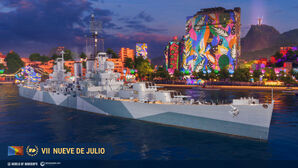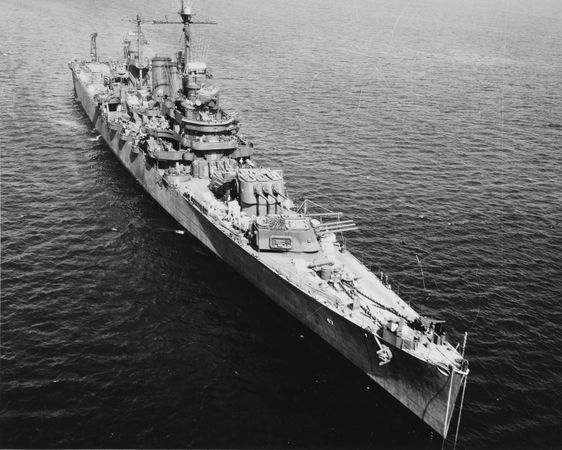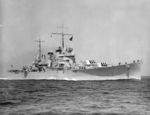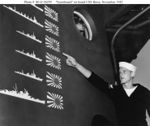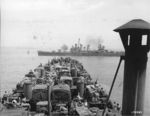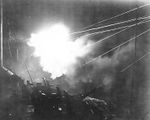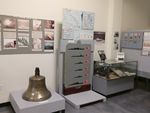Nueve de Julio
| Revision as of 12:29, 23 July 2018 added pictures to historical gallery | Revision as of 16:27, 23 July 2018 Overall polish. Added historical photos. | |||
| Line 20: | Line 20: | |||
| |Pros=<!-- write list of positive points below. use * as in ordinary wiki-list. --> | |Pros=<!-- write list of positive points below. use * as in ordinary wiki-list. --> | |||
| ? | * | + | * Armament is comparable to Tier VII American cruiser ''[[Helena]]'', but turret traverse is faster. | |
| ? | + | * Massive broadside firepower; landing most of an HE salvo on an enemy ship can do a significant amount of damage. | ||
| + | * Access to British-style {{Repair Party}} gives her excellent survivability for a Tier VII cruiser. | |||
| + | * Three rear facing turrets allows for effective kiting tactics. | |||
| + | * Good concealment. | |||
| + | * Quick rudder shift. | |||
| |Cons=<!-- write list of negative points below. use * as in ordinary wiki-list. --> | |Cons=<!-- write list of negative points below. use * as in ordinary wiki-list. --> | |||
| ? | * | + | * Weak broadside armor. | |
| ? | * | + | * Poor forward turret angles and high shell arcs. | |
| ? | * | + | * Slow for a Tier VII cruiser, with a large turning radius. | |
| ? | * | + | * Short main battery range (even shorter than ''[[Helena]]''). | |
| ? | * | + | * Requires Inertia Fuse for High Explosive skill to make her guns truly effective against other cruisers and battleships. | |
| + | * Has no torpedo protection. | |||
| + | * Slower main battery reload speed and weaker AA suite than ''Helena''. | |||
| |Research=<!-- write text about priority sequence of research below --> | |Research=<!-- write text about priority sequence of research below --> | |||
| ? | ||||
| ? | ||||
| ? | ||||
| ? | ||||
| ? | ||||
| ? | ||||
| ? | ||||
| ? | ||||
| ? | ||||
| As a premium ship, ''{{#var:ship_name}}'' doesn't have any upgrades to research. | As a premium ship, ''{{#var:ship_name}}'' doesn't have any upgrades to research. | |||
| Line 45: | Line 42: | |||
| |Upgrades=<!-- write text about best upgrades below, add * after upgrade link to designate that another upgrade may be viable --> | |Upgrades=<!-- write text about best upgrades below, add * after upgrade link to designate that another upgrade may be viable --> | |||
| ? | ||||
| The recommended upgrades for ''{{#var:ship_name}}'' are as follows: | The recommended upgrades for ''{{#var:ship_name}}'' are as follows: | |||
| * '''Slot 1''': {{Auxiliary Armaments Modification 1}} | * '''Slot 1''': {{Auxiliary Armaments Modification 1}} | |||
| Line 51: | Line 47: | |||
| * '''Slot 3''': {{AA Guns Modification 2}} | * '''Slot 3''': {{AA Guns Modification 2}} | |||
| * '''Slot 4''': {{Steering Gears Modification 2}}<nowiki>*</nowiki> | * '''Slot 4''': {{Steering Gears Modification 2}}<nowiki>*</nowiki> | |||
| ? | ||||
| '''Slot 4''' provides two viable upgrade options. Most captains will find {{Steering Gears Modification 2}} useful for increased maneuverability. Captains who prefer to use islands as cover will likely prefer {{Propulsion Modification 2}} in order to reposition more quickly, if spotted. | '''Slot 4''' provides two viable upgrade options. Most captains will find {{Steering Gears Modification 2}} useful for increased maneuverability. Captains who prefer to use islands as cover will likely prefer {{Propulsion Modification 2}} in order to reposition more quickly, if spotted. | |||
| Line 102: | Line 97: | |||
| * '''Slot 3:''' {{Repair Party}} | * '''Slot 3:''' {{Repair Party}} | |||
| ? | Mounting premium versions of these consumables is recommended to decrease their cooldown timers. ''Nueve de Julio'' has the choice between the {{Defensive AA Fire}} and {{Hydroacoustic Search}} consumables. {{Defensive AA Fire}} is useful against enemy aircraft while {{Hydroacoustic Search}} can be used to screen for torpedoes or enemy ships in a nearby smokescreen. | + | Mounting premium versions of these consumables is recommended to decrease their cooldown timers. ''Nueve de Julio'' has the choice between the {{Defensive AA Fire}} and {{Hydroacoustic Search}} consumables. {{Defensive AA Fire}} is useful against enemy aircraft while {{Hydroacoustic Search}} can be used to screen for torpedoes or enemy ships in a nearby smokescreen. | |
| |Camouflage=<!-- write text about useful camouflage below --> | |Camouflage=<!-- write text about useful camouflage below --> | |||
| ? | ||||
| ? | ||||
| ? | ||||
| ? | ||||
| ? | ||||
| ? | ||||
| ? | ||||
| ? | ||||
| ? | ||||
| ? | ||||
| As a premium ship, ''{{#var:ship_name}}'' comes included with [[Ship:Camouflage#Premium_Camouflage|Type 10 camouflage]] that lowers her detection radius, reduces the accuracy of incoming shells, reduces her repair costs, and increases the amount of experience she earns. | As a premium ship, ''{{#var:ship_name}}'' comes included with [[Ship:Camouflage#Premium_Camouflage|Type 10 camouflage]] that lowers her detection radius, reduces the accuracy of incoming shells, reduces her repair costs, and increases the amount of experience she earns. | |||
| |Signals=<!-- write text about best set of signals below --> | |Signals=<!-- write text about best set of signals below --> | |||
| ? | ''{{#var:ship_name}}'' is a | + | ''{{#var:ship_name}}'' is a light cruiser, meaning that most cruiser signals will work for her. Players may want to use signals to boost the fire chance ({{India X-Ray|Size=18px}} {{Victor Lima|Size=18px}}), consumable cool down ({{November Foxtrot|Size=18px}}), and heal amount ({{India Delta|Size=18px}}). As a premium ship, players may also want to use economic signals, but her nation limits captain training abilities. | |
| {{Signal Flags | {{Signal Flags | |||
| Line 160: | Line 145: | |||
| <div class="thumb tright"> | <div class="thumb tright"> | |||
| {{AnnoWiki|content= | {{AnnoWiki|content= | |||
| ? | <h2>''{{#var:ship_name}}'', | + | <h2>''{{#var:ship_name}}'', 1951</h2> | |
| ===Construction=== | ===Construction=== | |||
| :Builder: Yard; City, Country | :Builder: Yard; City, Country | |||
| Line 207: | Line 192: | |||
| : | : | |||
| }}</div> | }}</div> | |||
| ? | [[File: | + | [[File:Boise September 1945.jpg|none|frame|x450px|link=|USS ''Boise'' (CL-47) off San Pedro, California, 14 September 1945, following overhaul.]] | |
| ===History=== | ===History=== | |||
| ? | ||||
| ====Design==== | ====Design==== | |||
| + | After the London Naval Treaty in 1930 restricted the construction of "heavy" cruisers, the navies of Japan, Great Britain, and the United States started looking for alternatives which would combine similar strong firepower without violating the treaty. The solution was found in so-called "light" cruisers. Instead of maintaining their predecessors' focus on larger main battery gun diameters (typical 203mm), light cruisers would attempt to cram large quantities of smaller (150-155mm) barrels into hulls featuring improved armor protection. In Japan, this led to the ''[[Mogami]]'' class, armed with a heavy torpedo armament and five triple 155mm barrel turrets (though these ships would later be converted into heavy cruisers with 203mm barrels instead). The Royal Navy began development of what would become the [[Ship:Edinburgh|Town]] class, also featuring a torpedo armament as well as twelve 152mm guns in four triple turrets. | |||
| ? | + | By this time, the United States had dropped the idea of a torpedo armament aboard their cruisers (excluding the later ''[[Atlanta]]'' class, which would fill a special role). Though the ''[[Pensacola]]''-class cruisers were built with torpedoes, where were removed from all vessels of the class during refits in the 1930's. Thus, the ''Brooklyn'' class was not intended to carry torpedoes, focusing on other aspects of the cruiser's perceived role. Five 152mm triple-barrel turrets, mounted along the center line, formed the primary armament. Compared to the armament of the preceding ''[[Omaha]]'' class, the firepower the ''Brooklyn'' class was staggering; the ''Brooklyn''s had almost twice the firepower in a broadside, and the improved shells helped ensure better damage-dealing and penetration. The secondary armament consisted of eight (8) single-mounted 127mm guns, which could also be used against aircraft. Eight .50-caliber machine guns were added to provided close-range AA defense. | ||
| ? | + | The armor protection was vastly improved compared to the older light cruisers, with a 127mm thick belt protecting the vital areas of the vessel and a 51mm deck over the citadel. The steam turbines could pump out nearly 100,000 shaft horsepower, which allowed for a design speed of 32.5 knots. Unlike all preceding American cruisers, the aircraft facilities — including the hangar and the catapult(s) — were moved to the stern of the ship, with the hangar being a part of the ship’s hull. This freed up a lot of space amidships, which would later be used for additional armament. | ||
| ? | The armor protection was vastly improved compared to the older light | + | ||
| ? | The ship’s displacement upon | + | The ship’s displacement upon completion was 9,767 tons standard (12,200 tons fully loaded). The ''Brooklyn''-class cruisers were, thusly, legal by the terms of the London Naval Treaty and were, unlike their Japanese counterparts, not overweight. | |
| ? | With the attack on Pearl Harbor demonstrating the need of strong AA defenses on warships, the US realized that the | + | With the attack on Pearl Harbor forcibly demonstrating the need of strong AA defenses on warships, the US realized that the anti-aircraft armament on most of their ships was insufficient. However, as the famous 40mm Bofors had yet to enter service in the quantities needed, stop-gap measures were deemed acceptable. These included installation of the 28mm "Chicago pianos", and even some older 76.2mm guns. It was not until late 1942 when the ships of the ''Brooklyn'' class started receiving equipment that could provide the AA firepower envisioned by their designers: twenty-eight (28) 40mm Bofors cannons, plus an additional twenty (20) 20mm Oerlikon guns (with the dual-purpose 127mm armament remaining unchanged). | |
| ====Service==== | ====Service==== | |||
| ? | USS ''Boise'' (CL-47) was laid down at the Newport News Shipbuilding and Drydock Company in Newport News, Virginia, on | + | USS ''Boise'' (CL-47) was laid down at the Newport News Shipbuilding and Drydock Company in Newport News, Virginia, on 1 April 1935, launched on 3 December 1936, and commissioned into the United States Navy as the second-to-last ''Brooklyn''-class cruiser on 12 August 1938. ''Boise''’s shakedown cruise took her to Liberia and South Africa along the western coast of Africa, after which she transferred to the Pacific, where she operated between the US West Coast and Hawaii until November 1941. On the day of the Japanese air raid on Pearl Harbor, ''Boise'' found herself in the Philippines, in danger of being surrounded by Japanese warships. | |
| ? | + | |||
| ? | + | |||
| ? | + | ''Boise'' made a hasty voyage to Darwin, Australia, where she joined up with the light cruiser USS ''[[Marblehead]]'' (CL-12) and five ''[[Clemson]]''-class destroyers. She escorted a Dutch transport ship carrying supplies to the Dutch East Indies in January 1942, but in a twist of fate, on 21 January 1942, she struck an uncharted shoal and she had to return to Ceylon, then India, then finally the US for repairs. The mishap may have saved her from the fate that befell many Allied ships in the battles around Java. Her repairs were complete by mid-June 1942, and she was back at Pearl Harbor by early July. Her next mission was a dangerous one: a raiding cruise in Japanese waters, intended to cause enough confusion and chatter to cover up the Allied preparations for the Guadalcanal campaign. Departing Pearl on 27 July, she arrived at her raiding destination on 5 August, and completed her mission by the 8th (which was considered an success). Next, she covered the landing of Marine reinforcements on Guadalcanal in mid-September, supporting the mission she helped cover up. | ||
| ? | + | Her first battle came on the night of 11 October 1942. Alongside three other cruisers and five destroyers, ''Boise'' encountered three Japanese cruisers and two destroyers, and the Battle of Cape Esperance began. During the battle, ''Boise'' took multiple hits, but she answered with vicious volleys of fire, discovering the Japanese destroyer ''[[Fubuki]]'' less than a mile away. Her fifteen six-inch guns quickly crippled the Japanese destroyer, and she began to sink shortly after. ''Boise''’s most damaging hit came from the cruiser ''Kinugasa'', whose eight-inch shells struck the magazine between her 'A' and 'B' turrets. The hit caused a fire to erupt as her lower levels flooded, putting all 3 of her forward turrets out of action. ''Boise'' quickly retreated from the action to lick her wounds, eventually returning to the Philadelphia Navy Yard for repairs that lasted from late November 1942 until the 20 March 1943. | ||
| ? | + | On 8 June 1943, ''Boise'' sailed for the Mediterranean, arriving at Algiers on the 21st. From July to mid-August, ''Boise'' provided fire support for the Battle of Gela during the Allied invasion of Sicily, code-named Operation Husky. Following the successful invasion, she moved on to support the mainland landings at Taranto and Salerno during early September. She returned to New York on 15 November, then sailed for the South Pacific, arriving in south-eastern New Guinea on New Year's Eve 1943. | ||
| ? | ''Boise'' | + | From January to September 1944, ''Boise'' fought along the northern shoreline of New Guinea, providing supporting shore bombardments for Allied naval landings, moving north to support the occupation of the island of Morotai, one of the northernmost islands of the Dutch East Indies. Following this, she moved further north as the Allied Pacific fleets closed in on the Philippines. Joining the massive Leyte invasion force, she took part in her last naval battle on 25 October 1944: the Battle of Surigao Strait, during which a gargantuan Allied naval fleet surrounded and destroyed the seven-ship Japanese ‘Southern Force’ during the Battle of Leyte Gulf. She continued to support Allied naval landings until early May 1945, having sailed around almost every major island of the Philippines by this point. From the 3 to 16 June, she carried General Douglas MacArthur on a tour of Borneo and the central-southern Philippines, returning to San Pedro, California on 7 July 1945, where she would remain until October. | |
| + | That fall she sailed to New York, and remained there until she was decommissioned on 1 July 1946. | |||
| + | ''Boise'' sat idle in New York until 11 January 1951, when she — alongside her sister USS ''Phoenix'' (CL-46) — were sold to Argentina. She was re-named ARA ''Nueve de Julio'', in honor of the date of Argentine independence. Her only major action was during the ''Revolución Libertadora'', a civilian and military uprising which overthrew the democratic government and replaced it with a military dictatorship. ''Nueve de Julio'' — in support of the democratic government — shelled oil depots and military facilities along the southern shorelines of Argentina. She remained in active service until 1971, and she was moored at the main Argentinian naval base — Puerto Belgrano — for her last years. By the mid 1970’s, the rat-infested ship had been largely abandoned and had notably decayed. She was struck on 31 October 1977 and sold for scrap on 28 June 1981. She was slated to return to Brownsville, Texas in order to undergo conversion into a museum ship, but instead she was towed to Japan and scrapped in 1983. Her surviving sister, ARA ''General Belgrano'', was sunk on 2 May 1982 during the Falkwands War between Argentina and the United Kingdom. | |||
| |HistoricalGallery=<!-- write below list of files with description (if necessary) separated with | --><gallery> | |HistoricalGallery=<!-- write below list of files with description (if necessary) separated with | --><gallery> | |||
| ? | File:USS Boise (CL-47) underway 1938.jpg|'' | + | File:USS Boise (CL-47) underway 1938.jpg|USS ''Boise'' (CL-47) during sea trials, 7 July 1938. | |
| ? | File: | + | File:Boise damage.jpg|''Boise''’s gunfire damage diagram from 11-12 October 1942 off Savo Island. | |
| ? | File:0404725.jpg|'' | + | File:Boise_scoreboard.jpg |A sailor points out details of the Japanese trophy flags painted on ''Boise''’s pilothouse as a scoreboard of enemy ships claimed sunk in the Battle of Cape Esperance, 11-12 October 1942. | |
| ? | File:ARA_Nueve_de_Julio_(C-5)(ex-USS_Boise,_CL-47).jpg|'' | + | File:Boise during Sicily invasion.jpg|''Boise'' fires on enemy forces near Gela, Sicily, 11 July 1943. Photo taken from aboard LST-325. | |
| ? | File:ARA_Nueva_de_Julio_tied_up_pierside_and_her_sister_General_Belgrano.jpg|'' | + | File:Boise bombards New Guinea.jpg|''Boise'' shelling the coast of New Guinea, 10 February 1944. | |
| + | File:Boise in New York 1945.jpg|''Boise'' arrives in New York Harbor on 20 October 1945, to participate in the Navy Day Fleet Review. The south end of Manhattan Island is in the background. | |||
| + | File:0404725.jpg|ARA ''Nueve de Julio'' at sea, date and location unknown. | |||
| + | File:ARA_Nueve_de_Julio_(C-5)(ex-USS_Boise,_CL-47).jpg|ARA ''Nueve de Julio'' at sea, date and location unknown. | |||
| + | File:ARA_Nueva_de_Julio_tied_up_pierside_and_her_sister_General_Belgrano.jpg|''Nueve de Julio'' tied up pierside with her sister ''General Belgrano'' on her starboard side, date unknown. | |||
| + | File:IdahoMilitaryHistoryMuseumUSSBoiseCL-47Exhibit.jpg|The ship's bell of USS ''Boise'' was saved whilst she was being scrapped, and is on display at the [https://museum.mil.idaho.gov/ Idaho Military History Museum] in Boise, Idaho. | |||
| </gallery> | </gallery> | |||
Revision as of 16:27, 23 July 2018
| 152 mm/47 Mk.16 in a turret5 х 3 pcs. |
| Rate of Fire6 shots/min. |
| Reload Time10 sec. |
| Rotation Speed10 deg./sec. |
| 180 Degree Turn Time18 sec. |
| Firing Range13.56 km. |
| Maximum Dispersion126 m. |
| HE Shell152 mm HE/HC Mk34 |
| Maximum HE Shell Damage2,200 |
| Chance of Fire on Target Caused by HE Shell12 % |
| Initial HE Shell Velocity812 m./s. |
| HE Shell Weight47.6 kg. |
| AP Shell152 mm AP Mk35 |
| Maximum AP Shell Damage3,200 |
| Initial AP Shell Velocity762 m./s. |
| AP Shell Weight59 kg. |
| 127 mm/25 Mk.13 on a Mk.27 mount8 х 1 pcs. |
| Firing Range5.6 km. |
| Rate of Fire13.33 shots/min. |
| Reload Time4.5 sec. |
| HE Shell127 mm HE/HC Mk36 |
| Maximum HE Shell Damage1,800 |
| Initial HE Shell Velocity657 m./s. |
| Chance of Fire on Target Caused by HE Shell9 % |
| 127 mm/25 Mk.13 on a Mk.27 mount8 х 1 pcs. |
| . . . Average Damage per Second58.4 |
| . . . Firing Range4.2 km. |
| 20 mm Oerlikon on a Mk.20 mount8 х 2 pcs. |
| . . . Average Damage per Second48.8 |
| . . . Firing Range2.01 km. |
| 40 mm Bofors on a Mk.2 mount4 х 4 pcs. |
| . . . Average Damage per Second63.6 |
| . . . Firing Range3.51 km. |
| 40 mm Bofors on a Mk.1 mount6 х 2 pcs. |
| . . . Average Damage per Second67.8 |
| . . . Firing Range3.51 km. |
| Maximum Speed30 knot |
| Turning Circle Radius690 m. |
| Rudder Shift Time9.2 sec. |
| Surface Detectability Range11.52 km. |
| Air Detectability Range6.06 km. |
Nueve de Julio — Pan-American premium Tier VII cruiser.
Modules
Compatible Upgrades
| Slot 1 |
||||
|---|---|---|---|---|
| Slot 2 |
||||
| Slot 3 |
||||
| Slot 4 |
Player Opinion
Performance
Pros:
- Armament is comparable to Tier VII American cruiser Helena, but turret traverse is faster.
- Massive broadside firepower; landing most of an HE salvo on an enemy ship can do a significant amount of damage.
- Access to British-style Repair Party
 gives her excellent survivability for a Tier VII cruiser.
gives her excellent survivability for a Tier VII cruiser.
- Three rear facing turrets allows for effective kiting tactics.
- Good concealment.
- Quick rudder shift.
Cons:
- Weak broadside armor.
- Poor forward turret angles and high shell arcs.
- Slow for a Tier VII cruiser, with a large turning radius.
- Short main battery range (even shorter than Helena).
- Requires Inertia Fuse for High Explosive skill to make her guns truly effective against other cruisers and battleships.
- Has no torpedo protection.
- Slower main battery reload speed and weaker AA suite than Helena.
Research
Optimal Configuration
Upgrades
The recommended upgrades for Nueve de Julio are as follows:
- Slot 1: Auxiliary Armaments Modification 1

- Slot 2: Steering Gears Modification 1

- Slot 3: AA Guns Modification 2 (
 )
)
- Slot 4: Steering Gears Modification 2
 *
*
Slot 4 provides two viable upgrade options. Most captains will find Steering Gears Modification 2 ![]() useful for increased maneuverability. Captains who prefer to use islands as cover will likely prefer Propulsion Modification 1 (
useful for increased maneuverability. Captains who prefer to use islands as cover will likely prefer Propulsion Modification 1 (![]() ) in order to reposition more quickly, if spotted.
) in order to reposition more quickly, if spotted.
Commander Skills
Key skills for Nueve de Julio commanders include the regular set of skills for light cruisers; priority being on Inertia Fuse for High Explosive Shells and Concealment Expert. Superintendent is also valuable for the additional Repair Party consumable.
| Recommended Commander Skills | ||||||||
|---|---|---|---|---|---|---|---|---|
| Cost (points) |
Endurance | Attack | Support | Versatility | ||||
| 1 |
★★★ |
★★ |
★ |
|
|
|
★ |
|
| 2 |
★ |
★★ |
★★ |
|
|
|
★★ |
★ |
| 3 |
★★ |
|
|
|
|
★★★ |
★★★ |
★ |
| 4 |
|
★ |
★★★ |
|
★★ |
|
★ |
★★★ |
| Key: ★★★ - Extremely Useful ★★ - Frequently Useful ★ - Occasionally Useful No stars - Meh Χ - Not recommended | ||||||||
Consumables
Nueve de Julio can equip the following consumables:
- Slot 1: Damage Control Party

- Slot 2: Defensive AA Fire
 or Hydroacoustic Search
or Hydroacoustic Search 
- Slot 3: Repair Party

Mounting premium versions of these consumables is recommended to decrease their cooldown timers. Nueve de Julio has the choice between the Defensive AA Fire ![]() and Hydroacoustic Search
and Hydroacoustic Search ![]() consumables. Defensive AA Fire
consumables. Defensive AA Fire ![]() is useful against enemy aircraft while Hydroacoustic Search
is useful against enemy aircraft while Hydroacoustic Search ![]() can be used to screen for torpedoes or enemy ships in a nearby smokescreen.
can be used to screen for torpedoes or enemy ships in a nearby smokescreen.
Camouflage
As a premium ship, Nueve de Julio comes included with Type 10 camouflage that lowers her detection radius, reduces the accuracy of incoming shells, reduces her repair costs, and increases the amount of experience she earns.
Signals
Nueve de Julio is a light cruiser, meaning that most cruiser signals will work for her. Players may want to use signals to boost the fire chance (![]()
![]() ), consumable cool down (
), consumable cool down (![]() ), and heal amount (
), and heal amount (![]() ). As a premium ship, players may also want to use economic signals, but her nation limits captain training abilities.
). As a premium ship, players may also want to use economic signals, but her nation limits captain training abilities.
Recommended Signal Flags 
| |||||
|---|---|---|---|---|---|
| Combat | |||||
 ★ |

|
 ★ |

|
 ★★ |
 ★★ |

|

|
 ★ |
 ★ |
 ★ |
 ★★ |

|

| ||||
Note: Use of the Juliet Charlie signal makes detonation impossible.
Gallery
Historical Info
Historical Gallery
| Destroyers | VI Juruá |
| Cruisers | I Hércules • II Almirante Barroso • II Almirante Abreu |
| Battleships | V Rio de Janeiro |
| Aircraft Carriers |
